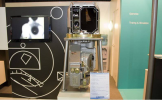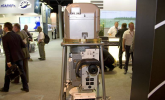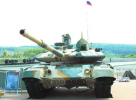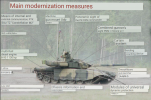Juu, näin se on. Ensimmäiset panssarivaunuihin sovitetut kaasuturbiinimoottorit olivat melkein suoraan helikoptereista otettuja, vaan eivät soveltuneet sellaisenaan. Vaati oman kehitystyönsä ennen kuin saatiin kestämään erilaista käyttöä.
Lainaan seuraavan pätkän S. Suvorov kirjasta Танки Т-80 - С. Суворов М. Барятинский (julkaistu vuonna 2002):
...the overall dimensions of the T-80 are closer to the T-72. Being the heaviest, however, it has the highest specific power due to the installation of a 1000 hp engine. against 700 hp the T-64A and 780 hp the T-72 is not inferior to the latter in terms of maneuverability.
-
Hän kirjoittaa samassa kirjassa ensimmäisestä Tsetsenian sodasta, jossa nämä vaunut saivat huonon maineen:
Tanks T-80B and T-80BV were used by the Russian Army during the military operation in Chechnya in 1995-1996. First of all, it should be noted that the Eighties, as, indeed, almost all other armored vehicles, were used inadequately in the situation. In this connection, Operation Desert Storm can serve as a model. At that time, a list of types of weapons and military equipment corresponding to the situation was selected in advance. At the same time, stakes were placed on the widespread use of electronic warfare equipment, the use of high-precision weapons, air strikes, etc. It should be noted that the Iraqi fanaticism was, perhaps, even more than the Chechens. Had the Multinational Force, without proper training, resorted to the massive use of armored vehicles, the result of the whole operation might have been different.
It is from this position that the use of armored vehicles in Chechnya should be considered. It is quite obvious that tanks, infantry fighting vehicles and armored personnel carriers, which are in service with the Russian Army and internal troops of the Ministry of Internal Affairs (as, indeed, in service with any other army in the world), are not intended for combat operations in the city and in the mountains. Their use for this purpose requires both special equipment and special training of personnel. At the same time, it can be argued that the vast majority of equipment and personnel involved in Chechnya were not prepared to conduct any kind of military operations at all.
So, most of the tanks were not equipped with dynamic protection. As military experts stated, this was mainly due to the lack of time to prepare the operation and the lack of funds! On many tanks, the KDZ units were installed in a non-combat-ready state, that is, were they loaded with explosives. And this is in conditions when the Chechens more than the Chechens. Had the Multinational Force, without proper training, resorted to the massive use of armored vehicles, the result of the whole operation might have been different.
It is from this position that the use of armored vehicles in Chechnya should be considered. It is quite obvious that tanks, infantry fighting vehicles and armored personnel carriers, which are in service with the Russian Army and internal troops of the Ministry of Internal Affairs (as, indeed, in service with any other army in the world), are not intended for combat operations in the city and in the mountains. Their use for this purpose requires both special equipment and special training of personnel. At the same time, it can be argued that the vast majority of equipment and personnel involved in Chechnya were not prepared to conduct any kind of military operations at all.
So, most of the tanks were not equipped with dynamic protection. As military experts stated, this was mainly due to the lack of time to prepare the operation and the lack of funds! On many tanks, the KDZ units were installed in a non-combat-ready state, that is, were they loaded with explosives. And this is in conditions when the Chechens mainly cumulative anti-tank ammunition (rocket-propelled grenades and ATGMs) were used. At the same time, the shooting was carried out almost point-blank and from the most favorable angles. The most vulnerable in the tanks were the sides, the stern, the MTO roof and the stern of the turret. In addition, numerous damage to the sides of combat vehicles was recorded when firing from the bottom up. All this suggests that the fire was fired simultaneously from the semi-basements, from the ground level and from the first floors of buildings, as well as from the upper floors. The density of firing from anti-tank weapons during street fighting in Grozny was 6 7 units for each tank - infantry fighting vehicles and armored personnel carriers. In the hulls of almost every wrecked tank or infantry fighting vehicle there were numerous holes (on average 3 - 6), each of which would be quite enough just to disable the machine. It should be noted that under these conditions, the T-72 tank proved to be the most survivable. As for the T-80 tank, in Chechnya there were cases of explosion of the combat kit when the side of the hull was hit and the cumulative jet hit the shells. This was due to the vertical location of the ammunition in the transporter of the automatic loader. In this case, the upper section of the track roller, which in this case served as an anti-cumulative screen, was below the level of the conveyor.
-
Suvorovin kirjoituksia on kritisoitu eri syistä, mutta olen lukenut muistakin lähteistä että osan vaunuista puuttui Kontakt-1 elementit koteloiden sisältä. Toisaalta sodasta on myös kirjoituksia ja kuvia sellaisista vaunuista, joissa elementit olivat paikallaan: näistä muuta otti vastaan (väitetysti) useita RPG-7 osumia ja miehistö sekä vaunu selvisivät hengissä. Kontakt-1 toimi siis suunnitellulla tavalla.
En usko että T-80 vaunujen ongelmat olivat tälle vaunuperheelle ainutkertaisia: jos sodassa olisi käytetty T-64 tai T-72 vaunuja enemmän, ne olisivat todennäköisesti kärsineet yhtä pahasti. Varsinkin venäläisissä lähteissä on kritisoitu rajusti T-80 vaunuja, osaksi aiheesta mutta osaksi sen takia, jotta saadaan nostettua "omien vaunujen" eli T-72 ja varsinkin T-90 mainetta. Poljetaan siis yhtä alas jotta oma vaunu näyttää paremmalta. Kaikkea kritiikkiä en niele purematta, mutta on hyvin selvä miksi heidän oli loogista panostaa enemmän T-72 vaunuperheeseen kylmän sodan päättymisen jälkeen: niitä oli tehty varastoon selvästi suurin määrä verrattuna T-64 ja T-80 vaunuihin JA toisaalta Nizhny Tagilin tehdas oli koko kylmän sodan ajan selvästi parhaassa iskussa: tuottivat aina suurimmat määrät eri vaunuja per vuosi. Venäjän kannalta oli siis loogista että vanhojen vaunujen modernisointi ja uusien (vaikkakin pienimuotoinen) tuotanto keskitettiin yhteen paikkaan ja Nizhny Tagil oli näistä parhaiten tähän soveltuva. Kharkovan tehdas jäi Ukrainan puolelle ja Pietarin tehtaiden tuotanto hiipui hyvin nopeasti 90-luvulle tultaessa.
-
MUOKKAUS: kokeilin hakea vaan tämä ei ilmeisesti ollut tässä ketjussa:
Ukrainalaisten panssarimiesten ajatuksia T-80BVM panssarivaunusta.
Lyhyesti tiivistettynä:
-kaapatut vaunut ovat melkein kuin uusia, hyvin vähän ajokilometrejä ja laukauksia tykillä. Ei siis juurikaan kuluneita osia, joten ennustavat pitkää käyttöikää
-kehuvat nopeutta, turbiinimoottori myös käynnistyy helposti kelissä kuin kelissä. Moottori vaatii tarkempaa ja erilaista huolenpitoa kuin diesel-moottorit mihin ovat tottuneet (eri varaosat, eri öljyt, eri huolto-ohjelma)
-kehuvat Sosna-U lämpökameraa, näkee kauas jopa 4-5 km ja erottaa pieniäkin kohteita (sanovat nähneensä villisian). Muistan että yhden venäläisen vaunumiehen mielestä nämä tähtäimet alkavat näyttämään ikäänsä ja ne pitäisi korvata paremmilla lähitulevaisuudessa. Tässä varmasti näkyy se mihin on totuttu, jos esim. ukrainalaiset tulevat T-64BV vaunuista tähän T-80BVM niin eroa on toki hurjasti.
-vaunussa on tietokone joka laskee laukaukset. Oletan että tämä ei tarkoita pelkästään kirjanpitoa laukausmääristä vaan automatiikkaa eri ampuma-arvojen osalta. Perinteisesti neukkuvaunulle (myös vanhemmille länsivaunuille) piti syöttää manuaalisisti mm. lämpötilat, etäisyydet yms. muuttujat ennen laukausta.
-polttoaineenkulutus mainitaan negatiivisena asiana, tämä ei yllätä, se on tunnettu ongelma jonka Neuvostoliittokin tiedosti. Samoin jenkeillä oli hyvin tiedossa, tosin APU-moottori auttaa varmasti jonkin verran.
Tällä videolla ei mainita, mutta olen kuullut muissa arvioissa kehuja turbiinimoottorisen vaunun hiljaisuudesta. Sillä pääsee kuulemma hivuttautumaan lähemmäs ilman että vaunun tulon kuulee niin helposti (kun vertaa isoon diesel-moottoriin). Toki optista tai lämpötähystystä se ei estä, vaikea sanoa kuinka hyödyllinen piirre tuo on. Turbiinin korkean ulinan varmasti kuulee jossain vaiheessa, mutta kuinka kaukaa, sitä en tiedä.
Koneinsinöörinä olen aina suhtautunut epäilevästi variaattoreihin, mutta olisi kiehtovaa nähdä, millainen voimapaketti saataisiin jos yhdistettäisiin moderni turbiinimoottori ja japanilaisen Type 10 vaunun variaattorivaihteisto. Muistan kuulleeni huhuja että heillä olisi ollut viime aikoina ongelmia variaattorien kanssa, tosin en muista yksityiskohtia. Kukaan muu ei käytä sellaista perinteisen vaihdelaatikon ja perän sijaan, joten ehkä ne eivät sovellu vaunukäyttöön? Ehkä suuri teho ja vääntö ovat liikaa, samoin nopeasti vaihteleva kuormitus? Tai ehkä kyse on perinteisistä lastentaudeista jotka saadaan jäljitettyä ja korjattua ajallaan. Teollisuudessa käytetään erikokoisia variaattoreita ja henkilöautopuolella niitä on nähnyt toisinaan, joten teknologia itsessään on tunnettu.


 Joo, minulla ei ole lihaa luiden ympärillä. Ajattelu meni niin, että kun kokonaisia vaunumiehistöjä koulutetaan 11½ kk:ssa ml. p-kausi, niin puolessa vuodessa täytyy jo onnistua muuntokoulutus uudelle vaunutyypille.
Joo, minulla ei ole lihaa luiden ympärillä. Ajattelu meni niin, että kun kokonaisia vaunumiehistöjä koulutetaan 11½ kk:ssa ml. p-kausi, niin puolessa vuodessa täytyy jo onnistua muuntokoulutus uudelle vaunutyypille. 




 .
. Säädöt vaihtuu napista painamalla bemarillekin pitää simuta rehellistä vastustajaa, eikä mitään supertankkia. Venäläisillä kun ei ole CV:tä.Toisaalta venäläisillä ei myöskään ole t55 tankkia johon skapparit heittää ressuille supersäädöt ja eikun kentälle.
Säädöt vaihtuu napista painamalla bemarillekin pitää simuta rehellistä vastustajaa, eikä mitään supertankkia. Venäläisillä kun ei ole CV:tä.Toisaalta venäläisillä ei myöskään ole t55 tankkia johon skapparit heittää ressuille supersäädöt ja eikun kentälle.